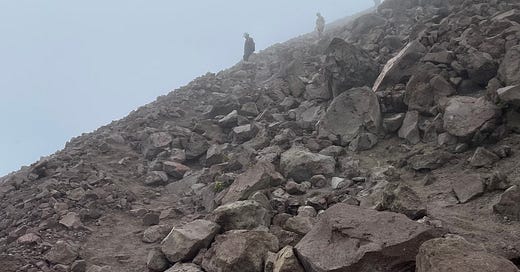Begin Here: No Shortcuts to Now
A Journey Through Stoicism, Myth, and the Art of Modern Resistance
No Shortcuts to Now began in the suspended stillness of the early Covid lockdown — as the man in the Oval Office insisted the virus would simply “go away,” as if by will and ignorance alone.
Not particularly reassured — and powerless to redirect the mad current of American events — I turned inward, and tried to cultivate my own small garden. My children needed their father as they stared into school-issued laptops, and I needed to make use of the strange gift of time the crisis had cracked open. So I wrote.
For years, I’d wanted to explore the ancient philosophical systems the modern world so often skips — especially Stoicism. In my undergraduate studies, the history of philosophy had leapt from Aristotle to Descartes, skipping the centuries that birthed one of the most enduring traditions of inner resistance. Now I had the chance. If not world enough, lockdown had at least given me time enough.
Each morning I rose before the sun, wrote for an hour or two, and then helped my kids with their lessons.
But I didn’t want to approach philosophy academically — not as a catalog of doctrines, but as a lived practice. I wanted to test ideas through experience, to draw on myth, memory, and meaning. All real wisdom must pass through the filter of life. So while I spent time hiking alongside the Stoics, I also traveled with Skeptics, Cynics, Epicureans — and with poets and thinkers of the Enlightenment — to see what they had to teach about how to live freely, and how to resist despots, tyrants, and clowns.
If I learned nothing else through this project, I at least figured out why people are terrified by clowns.
Though Stoicism became the backbone of this exploration, it was never the sole voice. It was the trail I kept returning to — a steady rhythm beneath the other steps — while I listened to the skeptics and poets along the way.
And I didn’t want to write only for myself. I wanted to leave my children something durable — a kind of intellectual toolbox. Not because they’re ready now for every lesson they’ll need, but because one day they will be.
So I turned the book into a kind of trail guide, built around a metaphor that also happened to be true: My son had dreamed for years of climbing a volcano. And we did. At the peak, he got altitude sickness — nausea, a pounding head, vomiting. I carried him down the trail; his “dream day” had become a disaster. But I told him to imagine telling his friends on Monday that he’d climbed a volcano and gotten “mountain sickness.” His imagination did the rest. He began to rewrite the story — and he finished the hike on his own feet.
“We don’t control what happens, but we can shape the stories we live by.”
That, I realized, was Stoicism in action: we don’t control what happens, but we can shape the stories we live by. That’s not a retreat from reality — it’s a way to face it with dignity.
The project gained quiet traction — until the 2020 election, when the president lost and began to lie with every sickening breath, even more forcefully from behind the Resolute Desk. When he incited the insurrection, my children watched me — stunned — kick one of their little chairs across the living room. My son began to cry, unable to understand his father’s rage. After 187 long minutes of silence, that same clown turned to his violent mob and said, with cold performative calm: “We love you. You’re very special.”
Not long after that—once I’d comforted my children—I came to understand something clearly: The ancient philosophers, especially the Stoics, developed their ideas in the shadow of exactly this kind of man. Their philosophy is not abstract. It is armor.
Though Stoicism plays a major role in this journey, it’s not the only voice in these pages. Myth, history, religion, and revolution thread through the work. What binds them is a question—not just how to endure, but how to live well, and act bravely, in an age of confusion and collapse.
I finished the first draft in the early Biden years, tried to find a publisher, and was told again and again that I lacked a “platform.” The project stalled. And then the 2024 election came — and that terrible clown returned. He has power again, and our country is in a bad way. But if the Stoics have taught me anything, it is this:
“The obstacle on the path becomes the path.” — Marcus Aurelius
So I’ve made a choice: instead of waiting for permission to publish, I’m serializing the book here, on Substack.
Each chapter will appear in sections I call Waypoints. You can expect one or two a week as I revise each for the present moment, and the political and moral terrain we now find ourselves in.
If this journey speaks to you, I hope you’ll subscribe, comment, and share it with someone else walking a similar path. Together, we’re building a quiet fellowship — seeking clarity, courage, and conscience in uncertain times.
Subscribers will get first access to new sections, and when the time comes to publish the full book as a physical or digital edition, you’ll be the first to know.
🧭 Let’s begin the journey: Waypoint 1.1.
Chapter 1 Index: Standing in The Ancient Shadow
Chapter 2 Index: The Soul’s Ascent 🔒



